Understanding and Leading Change in Business | Desklib
VerifiedAdded on 2023/06/04
|15
|4644
|470
AI Summary
This report discusses various issues related to change management in business, including drivers of change, impact on leadership decision-making, and models and theories of change. It also includes examples of Tesco and Marks and Spencer to compare and analyze the impact of changes in business processes and strategies.
Contribute Materials
Your contribution can guide someone’s learning journey. Share your
documents today.
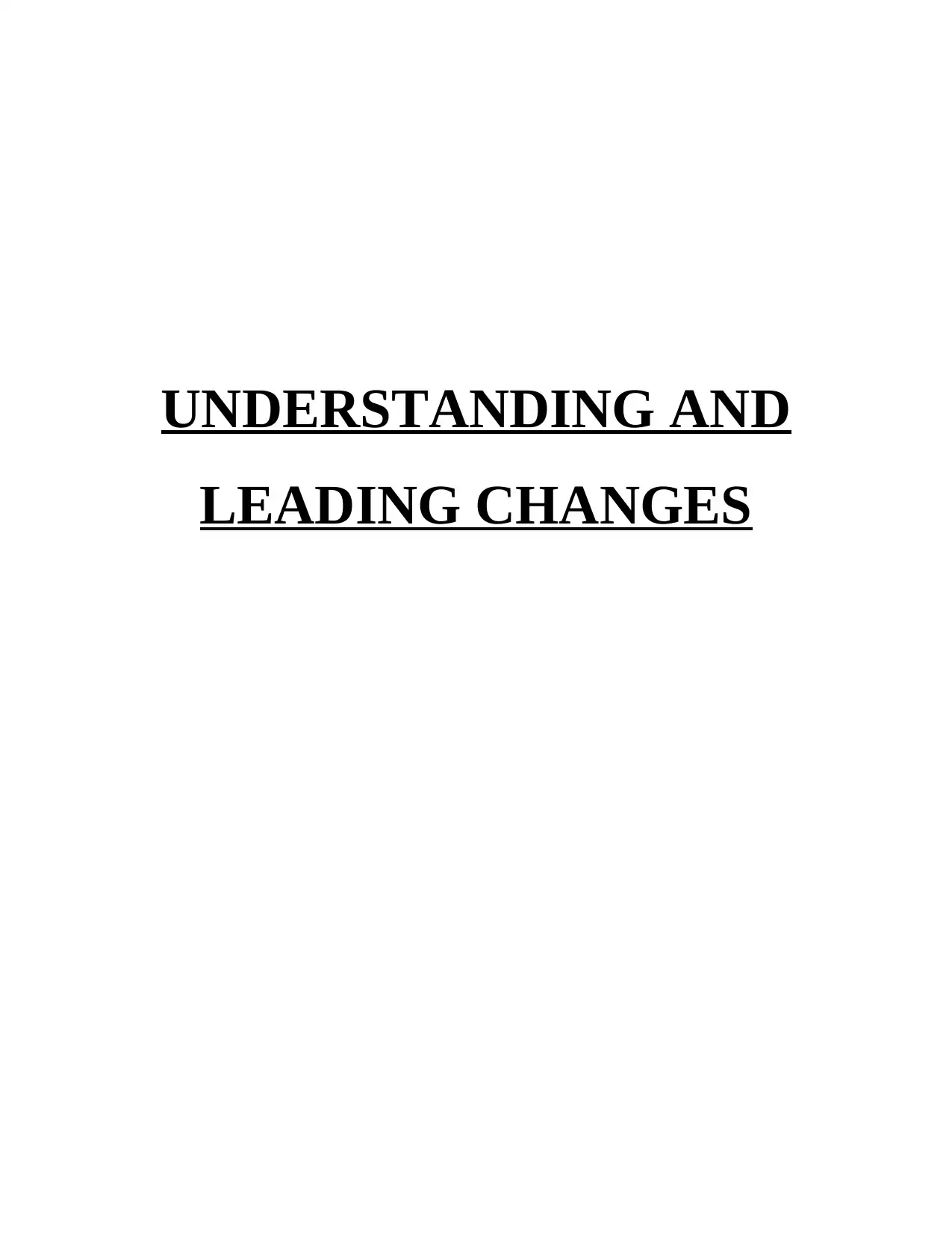
UNDERSTANDING AND
LEADING CHANGES
LEADING CHANGES
Secure Best Marks with AI Grader
Need help grading? Try our AI Grader for instant feedback on your assignments.
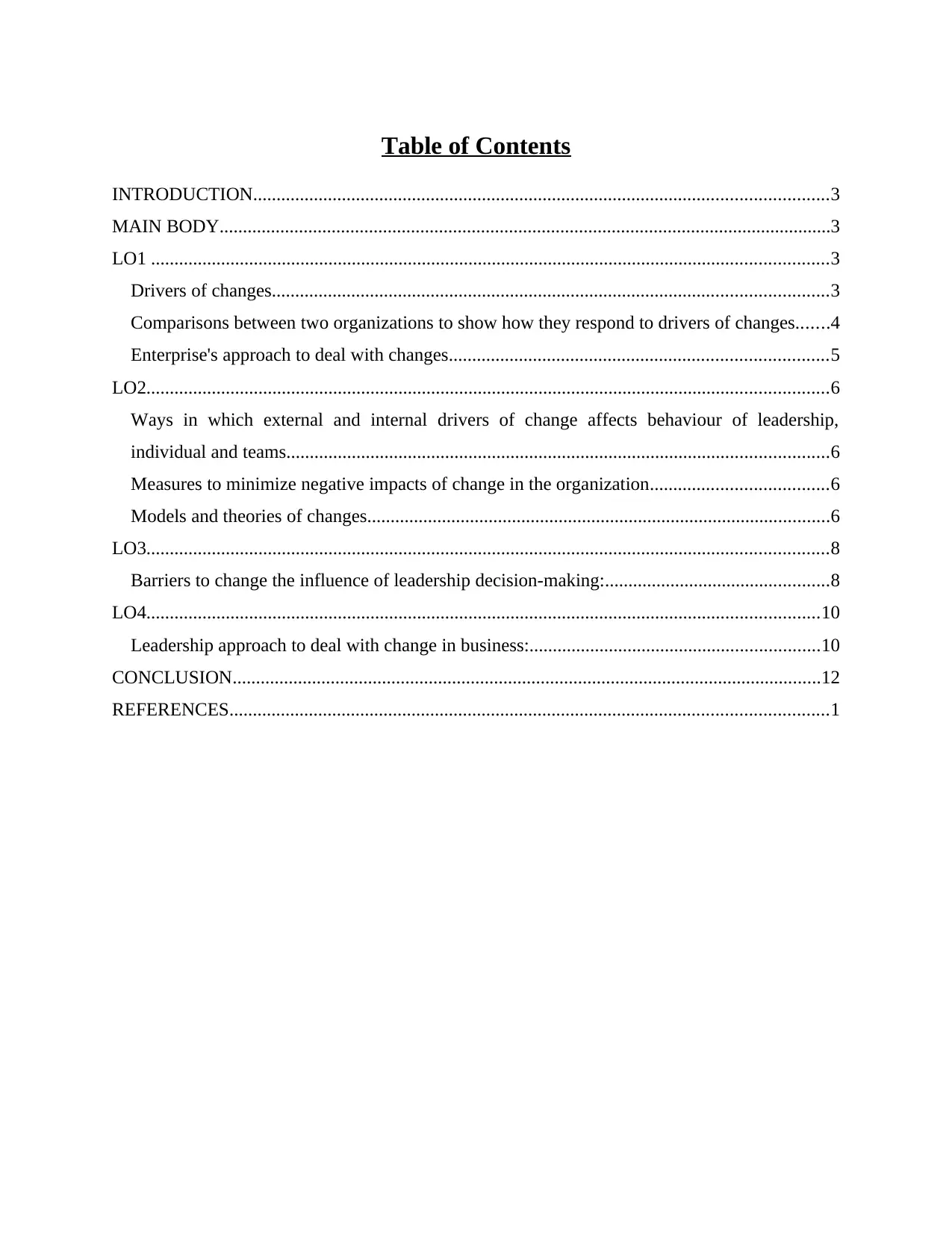
Table of Contents
INTRODUCTION...........................................................................................................................3
MAIN BODY...................................................................................................................................3
LO1 .................................................................................................................................................3
Drivers of changes.......................................................................................................................3
Comparisons between two organizations to show how they respond to drivers of changes.......4
Enterprise's approach to deal with changes.................................................................................5
LO2..................................................................................................................................................6
Ways in which external and internal drivers of change affects behaviour of leadership,
individual and teams....................................................................................................................6
Measures to minimize negative impacts of change in the organization......................................6
Models and theories of changes...................................................................................................6
LO3..................................................................................................................................................8
Barriers to change the influence of leadership decision-making:................................................8
LO4................................................................................................................................................10
Leadership approach to deal with change in business:..............................................................10
CONCLUSION..............................................................................................................................12
REFERENCES................................................................................................................................1
INTRODUCTION...........................................................................................................................3
MAIN BODY...................................................................................................................................3
LO1 .................................................................................................................................................3
Drivers of changes.......................................................................................................................3
Comparisons between two organizations to show how they respond to drivers of changes.......4
Enterprise's approach to deal with changes.................................................................................5
LO2..................................................................................................................................................6
Ways in which external and internal drivers of change affects behaviour of leadership,
individual and teams....................................................................................................................6
Measures to minimize negative impacts of change in the organization......................................6
Models and theories of changes...................................................................................................6
LO3..................................................................................................................................................8
Barriers to change the influence of leadership decision-making:................................................8
LO4................................................................................................................................................10
Leadership approach to deal with change in business:..............................................................10
CONCLUSION..............................................................................................................................12
REFERENCES................................................................................................................................1
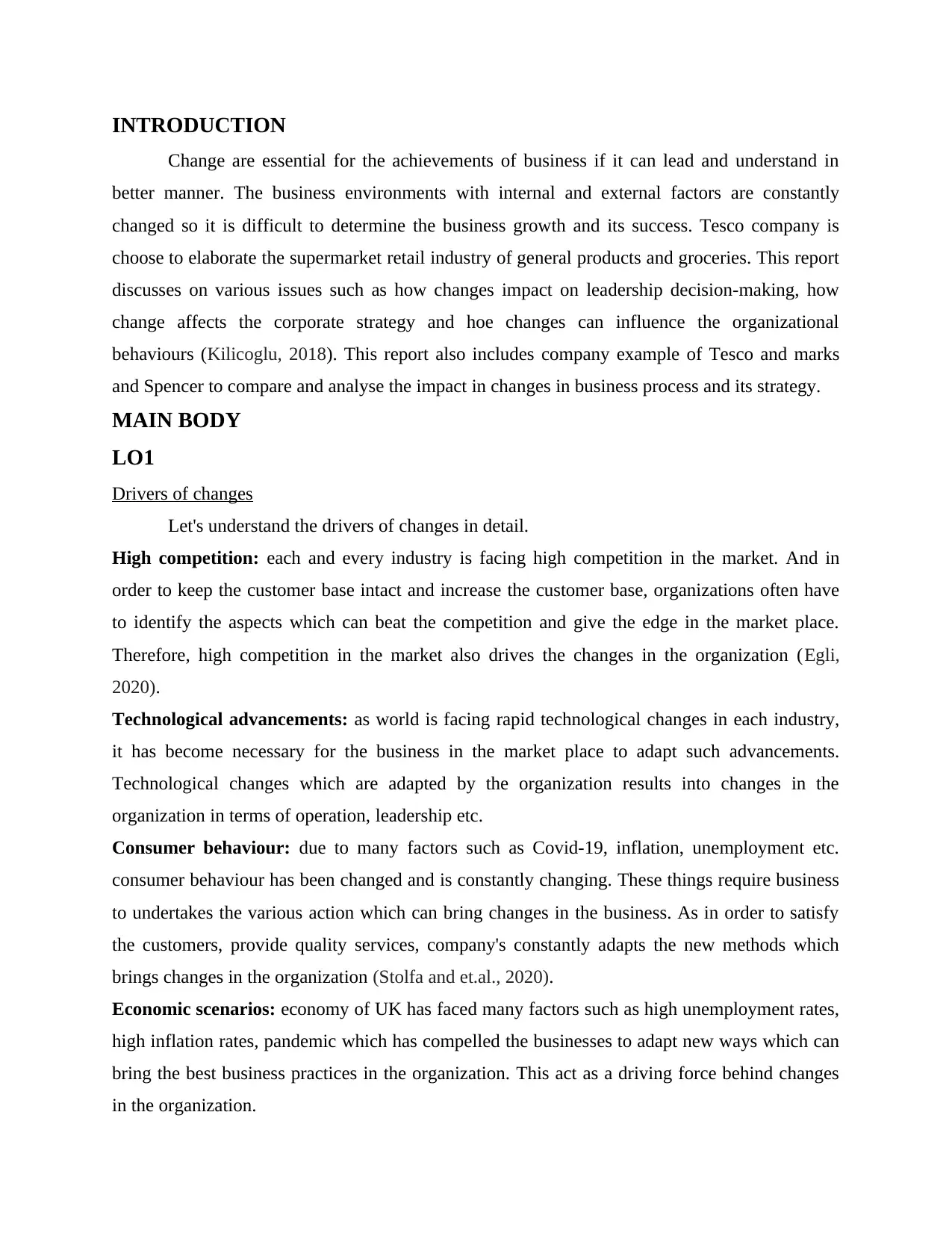
INTRODUCTION
Change are essential for the achievements of business if it can lead and understand in
better manner. The business environments with internal and external factors are constantly
changed so it is difficult to determine the business growth and its success. Tesco company is
choose to elaborate the supermarket retail industry of general products and groceries. This report
discusses on various issues such as how changes impact on leadership decision-making, how
change affects the corporate strategy and hoe changes can influence the organizational
behaviours (Kilicoglu, 2018). This report also includes company example of Tesco and marks
and Spencer to compare and analyse the impact in changes in business process and its strategy.
MAIN BODY
LO1
Drivers of changes
Let's understand the drivers of changes in detail.
High competition: each and every industry is facing high competition in the market. And in
order to keep the customer base intact and increase the customer base, organizations often have
to identify the aspects which can beat the competition and give the edge in the market place.
Therefore, high competition in the market also drives the changes in the organization (Egli,
2020).
Technological advancements: as world is facing rapid technological changes in each industry,
it has become necessary for the business in the market place to adapt such advancements.
Technological changes which are adapted by the organization results into changes in the
organization in terms of operation, leadership etc.
Consumer behaviour: due to many factors such as Covid-19, inflation, unemployment etc.
consumer behaviour has been changed and is constantly changing. These things require business
to undertakes the various action which can bring changes in the business. As in order to satisfy
the customers, provide quality services, company's constantly adapts the new methods which
brings changes in the organization (Stolfa and et.al., 2020).
Economic scenarios: economy of UK has faced many factors such as high unemployment rates,
high inflation rates, pandemic which has compelled the businesses to adapt new ways which can
bring the best business practices in the organization. This act as a driving force behind changes
in the organization.
Change are essential for the achievements of business if it can lead and understand in
better manner. The business environments with internal and external factors are constantly
changed so it is difficult to determine the business growth and its success. Tesco company is
choose to elaborate the supermarket retail industry of general products and groceries. This report
discusses on various issues such as how changes impact on leadership decision-making, how
change affects the corporate strategy and hoe changes can influence the organizational
behaviours (Kilicoglu, 2018). This report also includes company example of Tesco and marks
and Spencer to compare and analyse the impact in changes in business process and its strategy.
MAIN BODY
LO1
Drivers of changes
Let's understand the drivers of changes in detail.
High competition: each and every industry is facing high competition in the market. And in
order to keep the customer base intact and increase the customer base, organizations often have
to identify the aspects which can beat the competition and give the edge in the market place.
Therefore, high competition in the market also drives the changes in the organization (Egli,
2020).
Technological advancements: as world is facing rapid technological changes in each industry,
it has become necessary for the business in the market place to adapt such advancements.
Technological changes which are adapted by the organization results into changes in the
organization in terms of operation, leadership etc.
Consumer behaviour: due to many factors such as Covid-19, inflation, unemployment etc.
consumer behaviour has been changed and is constantly changing. These things require business
to undertakes the various action which can bring changes in the business. As in order to satisfy
the customers, provide quality services, company's constantly adapts the new methods which
brings changes in the organization (Stolfa and et.al., 2020).
Economic scenarios: economy of UK has faced many factors such as high unemployment rates,
high inflation rates, pandemic which has compelled the businesses to adapt new ways which can
bring the best business practices in the organization. This act as a driving force behind changes
in the organization.
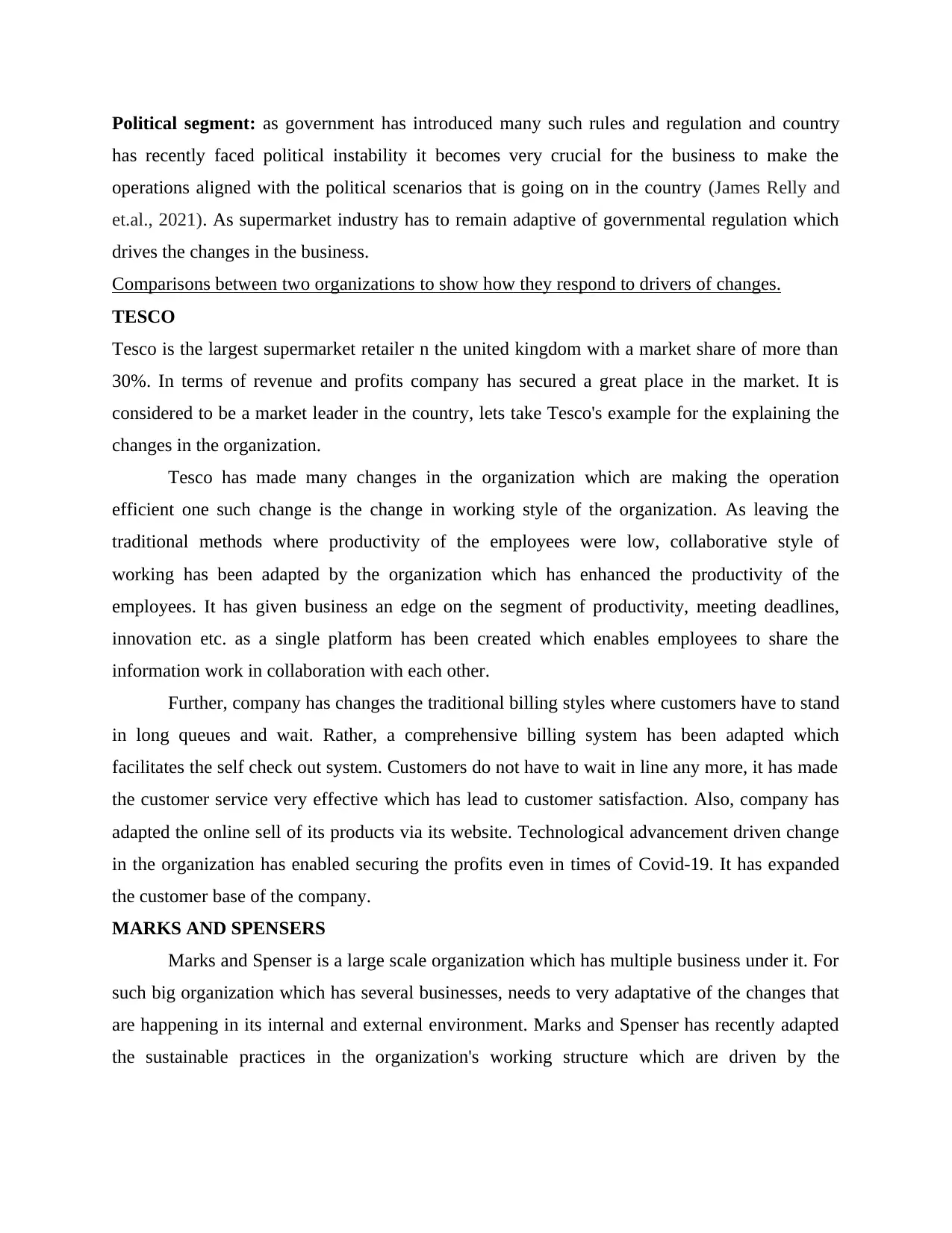
Political segment: as government has introduced many such rules and regulation and country
has recently faced political instability it becomes very crucial for the business to make the
operations aligned with the political scenarios that is going on in the country (James Relly and
et.al., 2021). As supermarket industry has to remain adaptive of governmental regulation which
drives the changes in the business.
Comparisons between two organizations to show how they respond to drivers of changes.
TESCO
Tesco is the largest supermarket retailer n the united kingdom with a market share of more than
30%. In terms of revenue and profits company has secured a great place in the market. It is
considered to be a market leader in the country, lets take Tesco's example for the explaining the
changes in the organization.
Tesco has made many changes in the organization which are making the operation
efficient one such change is the change in working style of the organization. As leaving the
traditional methods where productivity of the employees were low, collaborative style of
working has been adapted by the organization which has enhanced the productivity of the
employees. It has given business an edge on the segment of productivity, meeting deadlines,
innovation etc. as a single platform has been created which enables employees to share the
information work in collaboration with each other.
Further, company has changes the traditional billing styles where customers have to stand
in long queues and wait. Rather, a comprehensive billing system has been adapted which
facilitates the self check out system. Customers do not have to wait in line any more, it has made
the customer service very effective which has lead to customer satisfaction. Also, company has
adapted the online sell of its products via its website. Technological advancement driven change
in the organization has enabled securing the profits even in times of Covid-19. It has expanded
the customer base of the company.
MARKS AND SPENSERS
Marks and Spenser is a large scale organization which has multiple business under it. For
such big organization which has several businesses, needs to very adaptative of the changes that
are happening in its internal and external environment. Marks and Spenser has recently adapted
the sustainable practices in the organization's working structure which are driven by the
has recently faced political instability it becomes very crucial for the business to make the
operations aligned with the political scenarios that is going on in the country (James Relly and
et.al., 2021). As supermarket industry has to remain adaptive of governmental regulation which
drives the changes in the business.
Comparisons between two organizations to show how they respond to drivers of changes.
TESCO
Tesco is the largest supermarket retailer n the united kingdom with a market share of more than
30%. In terms of revenue and profits company has secured a great place in the market. It is
considered to be a market leader in the country, lets take Tesco's example for the explaining the
changes in the organization.
Tesco has made many changes in the organization which are making the operation
efficient one such change is the change in working style of the organization. As leaving the
traditional methods where productivity of the employees were low, collaborative style of
working has been adapted by the organization which has enhanced the productivity of the
employees. It has given business an edge on the segment of productivity, meeting deadlines,
innovation etc. as a single platform has been created which enables employees to share the
information work in collaboration with each other.
Further, company has changes the traditional billing styles where customers have to stand
in long queues and wait. Rather, a comprehensive billing system has been adapted which
facilitates the self check out system. Customers do not have to wait in line any more, it has made
the customer service very effective which has lead to customer satisfaction. Also, company has
adapted the online sell of its products via its website. Technological advancement driven change
in the organization has enabled securing the profits even in times of Covid-19. It has expanded
the customer base of the company.
MARKS AND SPENSERS
Marks and Spenser is a large scale organization which has multiple business under it. For
such big organization which has several businesses, needs to very adaptative of the changes that
are happening in its internal and external environment. Marks and Spenser has recently adapted
the sustainable practices in the organization's working structure which are driven by the
Secure Best Marks with AI Grader
Need help grading? Try our AI Grader for instant feedback on your assignments.
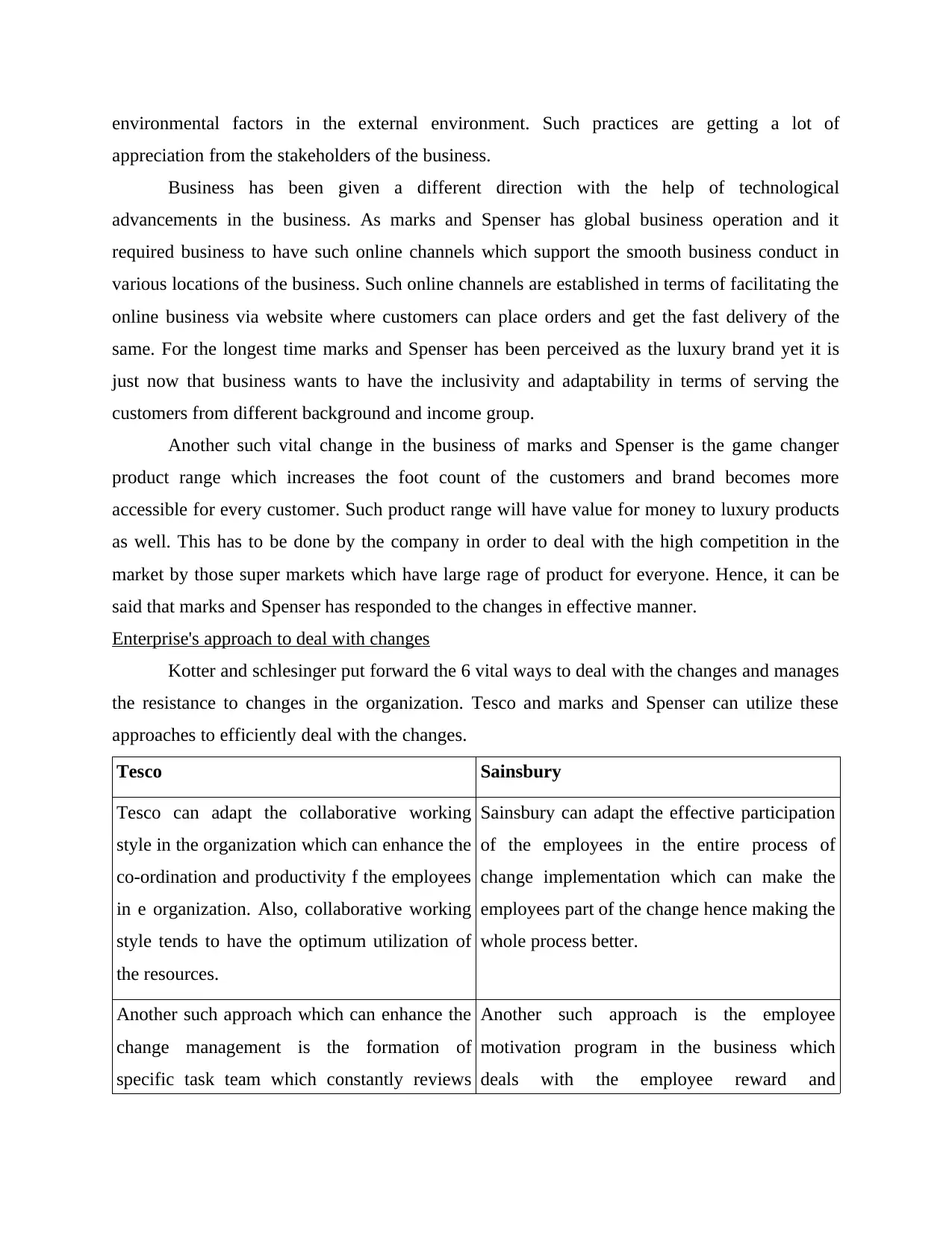
environmental factors in the external environment. Such practices are getting a lot of
appreciation from the stakeholders of the business.
Business has been given a different direction with the help of technological
advancements in the business. As marks and Spenser has global business operation and it
required business to have such online channels which support the smooth business conduct in
various locations of the business. Such online channels are established in terms of facilitating the
online business via website where customers can place orders and get the fast delivery of the
same. For the longest time marks and Spenser has been perceived as the luxury brand yet it is
just now that business wants to have the inclusivity and adaptability in terms of serving the
customers from different background and income group.
Another such vital change in the business of marks and Spenser is the game changer
product range which increases the foot count of the customers and brand becomes more
accessible for every customer. Such product range will have value for money to luxury products
as well. This has to be done by the company in order to deal with the high competition in the
market by those super markets which have large rage of product for everyone. Hence, it can be
said that marks and Spenser has responded to the changes in effective manner.
Enterprise's approach to deal with changes
Kotter and schlesinger put forward the 6 vital ways to deal with the changes and manages
the resistance to changes in the organization. Tesco and marks and Spenser can utilize these
approaches to efficiently deal with the changes.
Tesco Sainsbury
Tesco can adapt the collaborative working
style in the organization which can enhance the
co-ordination and productivity f the employees
in e organization. Also, collaborative working
style tends to have the optimum utilization of
the resources.
Sainsbury can adapt the effective participation
of the employees in the entire process of
change implementation which can make the
employees part of the change hence making the
whole process better.
Another such approach which can enhance the
change management is the formation of
specific task team which constantly reviews
Another such approach is the employee
motivation program in the business which
deals with the employee reward and
appreciation from the stakeholders of the business.
Business has been given a different direction with the help of technological
advancements in the business. As marks and Spenser has global business operation and it
required business to have such online channels which support the smooth business conduct in
various locations of the business. Such online channels are established in terms of facilitating the
online business via website where customers can place orders and get the fast delivery of the
same. For the longest time marks and Spenser has been perceived as the luxury brand yet it is
just now that business wants to have the inclusivity and adaptability in terms of serving the
customers from different background and income group.
Another such vital change in the business of marks and Spenser is the game changer
product range which increases the foot count of the customers and brand becomes more
accessible for every customer. Such product range will have value for money to luxury products
as well. This has to be done by the company in order to deal with the high competition in the
market by those super markets which have large rage of product for everyone. Hence, it can be
said that marks and Spenser has responded to the changes in effective manner.
Enterprise's approach to deal with changes
Kotter and schlesinger put forward the 6 vital ways to deal with the changes and manages
the resistance to changes in the organization. Tesco and marks and Spenser can utilize these
approaches to efficiently deal with the changes.
Tesco Sainsbury
Tesco can adapt the collaborative working
style in the organization which can enhance the
co-ordination and productivity f the employees
in e organization. Also, collaborative working
style tends to have the optimum utilization of
the resources.
Sainsbury can adapt the effective participation
of the employees in the entire process of
change implementation which can make the
employees part of the change hence making the
whole process better.
Another such approach which can enhance the
change management is the formation of
specific task team which constantly reviews
Another such approach is the employee
motivation program in the business which
deals with the employee reward and
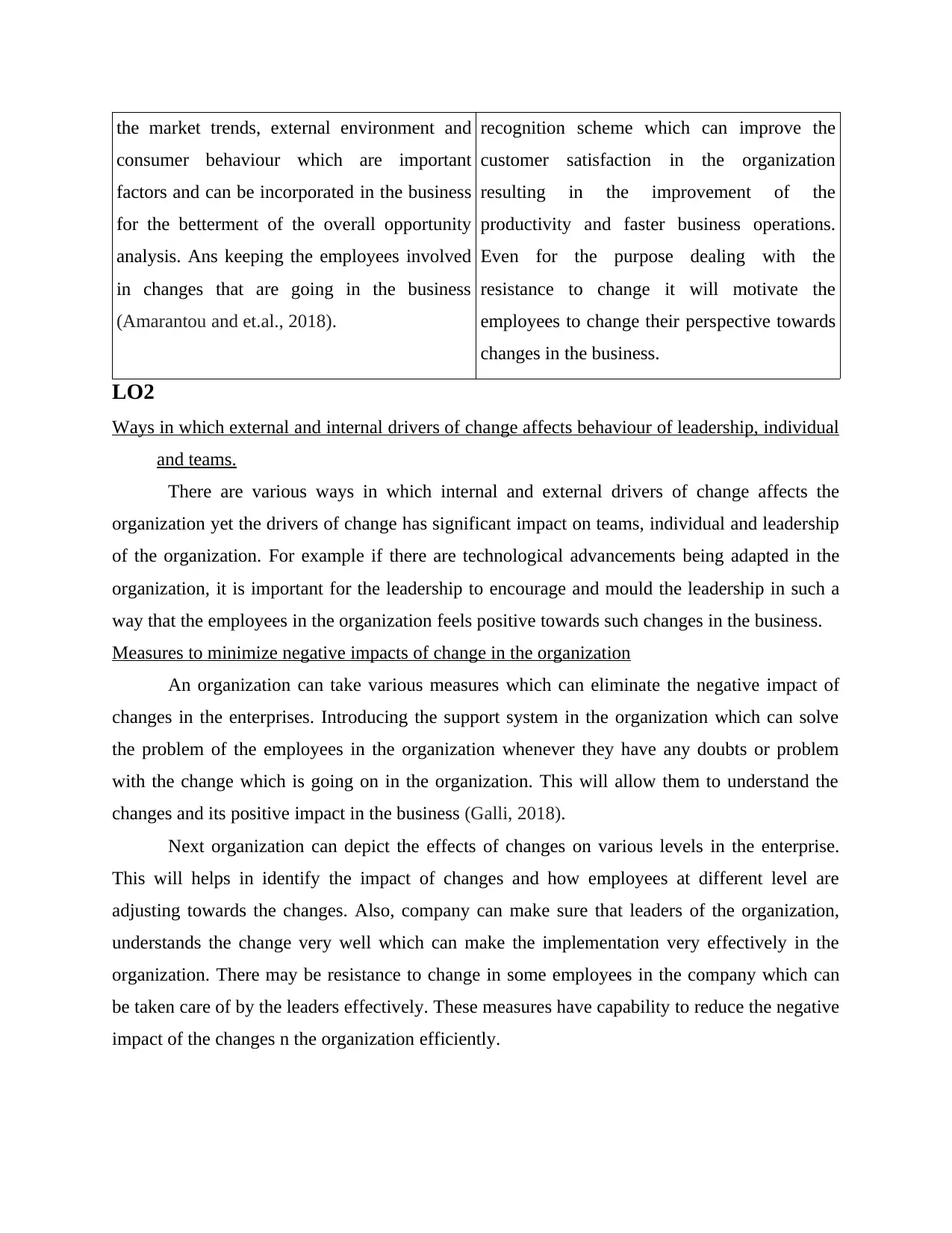
the market trends, external environment and
consumer behaviour which are important
factors and can be incorporated in the business
for the betterment of the overall opportunity
analysis. Ans keeping the employees involved
in changes that are going in the business
(Amarantou and et.al., 2018).
recognition scheme which can improve the
customer satisfaction in the organization
resulting in the improvement of the
productivity and faster business operations.
Even for the purpose dealing with the
resistance to change it will motivate the
employees to change their perspective towards
changes in the business.
LO2
Ways in which external and internal drivers of change affects behaviour of leadership, individual
and teams.
There are various ways in which internal and external drivers of change affects the
organization yet the drivers of change has significant impact on teams, individual and leadership
of the organization. For example if there are technological advancements being adapted in the
organization, it is important for the leadership to encourage and mould the leadership in such a
way that the employees in the organization feels positive towards such changes in the business.
Measures to minimize negative impacts of change in the organization
An organization can take various measures which can eliminate the negative impact of
changes in the enterprises. Introducing the support system in the organization which can solve
the problem of the employees in the organization whenever they have any doubts or problem
with the change which is going on in the organization. This will allow them to understand the
changes and its positive impact in the business (Galli, 2018).
Next organization can depict the effects of changes on various levels in the enterprise.
This will helps in identify the impact of changes and how employees at different level are
adjusting towards the changes. Also, company can make sure that leaders of the organization,
understands the change very well which can make the implementation very effectively in the
organization. There may be resistance to change in some employees in the company which can
be taken care of by the leaders effectively. These measures have capability to reduce the negative
impact of the changes n the organization efficiently.
consumer behaviour which are important
factors and can be incorporated in the business
for the betterment of the overall opportunity
analysis. Ans keeping the employees involved
in changes that are going in the business
(Amarantou and et.al., 2018).
recognition scheme which can improve the
customer satisfaction in the organization
resulting in the improvement of the
productivity and faster business operations.
Even for the purpose dealing with the
resistance to change it will motivate the
employees to change their perspective towards
changes in the business.
LO2
Ways in which external and internal drivers of change affects behaviour of leadership, individual
and teams.
There are various ways in which internal and external drivers of change affects the
organization yet the drivers of change has significant impact on teams, individual and leadership
of the organization. For example if there are technological advancements being adapted in the
organization, it is important for the leadership to encourage and mould the leadership in such a
way that the employees in the organization feels positive towards such changes in the business.
Measures to minimize negative impacts of change in the organization
An organization can take various measures which can eliminate the negative impact of
changes in the enterprises. Introducing the support system in the organization which can solve
the problem of the employees in the organization whenever they have any doubts or problem
with the change which is going on in the organization. This will allow them to understand the
changes and its positive impact in the business (Galli, 2018).
Next organization can depict the effects of changes on various levels in the enterprise.
This will helps in identify the impact of changes and how employees at different level are
adjusting towards the changes. Also, company can make sure that leaders of the organization,
understands the change very well which can make the implementation very effectively in the
organization. There may be resistance to change in some employees in the company which can
be taken care of by the leaders effectively. These measures have capability to reduce the negative
impact of the changes n the organization efficiently.
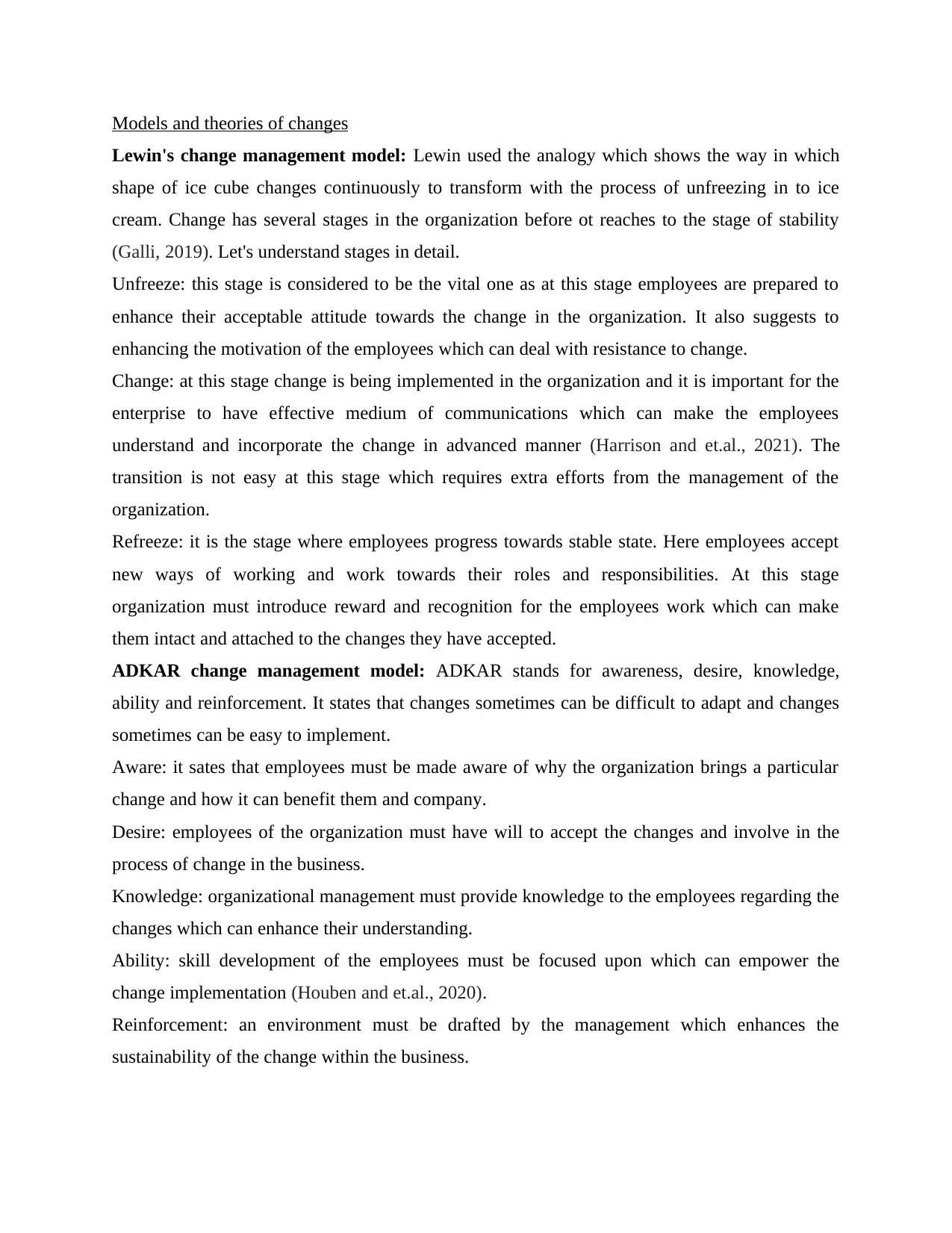
Models and theories of changes
Lewin's change management model: Lewin used the analogy which shows the way in which
shape of ice cube changes continuously to transform with the process of unfreezing in to ice
cream. Change has several stages in the organization before ot reaches to the stage of stability
(Galli, 2019). Let's understand stages in detail.
Unfreeze: this stage is considered to be the vital one as at this stage employees are prepared to
enhance their acceptable attitude towards the change in the organization. It also suggests to
enhancing the motivation of the employees which can deal with resistance to change.
Change: at this stage change is being implemented in the organization and it is important for the
enterprise to have effective medium of communications which can make the employees
understand and incorporate the change in advanced manner (Harrison and et.al., 2021). The
transition is not easy at this stage which requires extra efforts from the management of the
organization.
Refreeze: it is the stage where employees progress towards stable state. Here employees accept
new ways of working and work towards their roles and responsibilities. At this stage
organization must introduce reward and recognition for the employees work which can make
them intact and attached to the changes they have accepted.
ADKAR change management model: ADKAR stands for awareness, desire, knowledge,
ability and reinforcement. It states that changes sometimes can be difficult to adapt and changes
sometimes can be easy to implement.
Aware: it sates that employees must be made aware of why the organization brings a particular
change and how it can benefit them and company.
Desire: employees of the organization must have will to accept the changes and involve in the
process of change in the business.
Knowledge: organizational management must provide knowledge to the employees regarding the
changes which can enhance their understanding.
Ability: skill development of the employees must be focused upon which can empower the
change implementation (Houben and et.al., 2020).
Reinforcement: an environment must be drafted by the management which enhances the
sustainability of the change within the business.
Lewin's change management model: Lewin used the analogy which shows the way in which
shape of ice cube changes continuously to transform with the process of unfreezing in to ice
cream. Change has several stages in the organization before ot reaches to the stage of stability
(Galli, 2019). Let's understand stages in detail.
Unfreeze: this stage is considered to be the vital one as at this stage employees are prepared to
enhance their acceptable attitude towards the change in the organization. It also suggests to
enhancing the motivation of the employees which can deal with resistance to change.
Change: at this stage change is being implemented in the organization and it is important for the
enterprise to have effective medium of communications which can make the employees
understand and incorporate the change in advanced manner (Harrison and et.al., 2021). The
transition is not easy at this stage which requires extra efforts from the management of the
organization.
Refreeze: it is the stage where employees progress towards stable state. Here employees accept
new ways of working and work towards their roles and responsibilities. At this stage
organization must introduce reward and recognition for the employees work which can make
them intact and attached to the changes they have accepted.
ADKAR change management model: ADKAR stands for awareness, desire, knowledge,
ability and reinforcement. It states that changes sometimes can be difficult to adapt and changes
sometimes can be easy to implement.
Aware: it sates that employees must be made aware of why the organization brings a particular
change and how it can benefit them and company.
Desire: employees of the organization must have will to accept the changes and involve in the
process of change in the business.
Knowledge: organizational management must provide knowledge to the employees regarding the
changes which can enhance their understanding.
Ability: skill development of the employees must be focused upon which can empower the
change implementation (Houben and et.al., 2020).
Reinforcement: an environment must be drafted by the management which enhances the
sustainability of the change within the business.
Paraphrase This Document
Need a fresh take? Get an instant paraphrase of this document with our AI Paraphraser
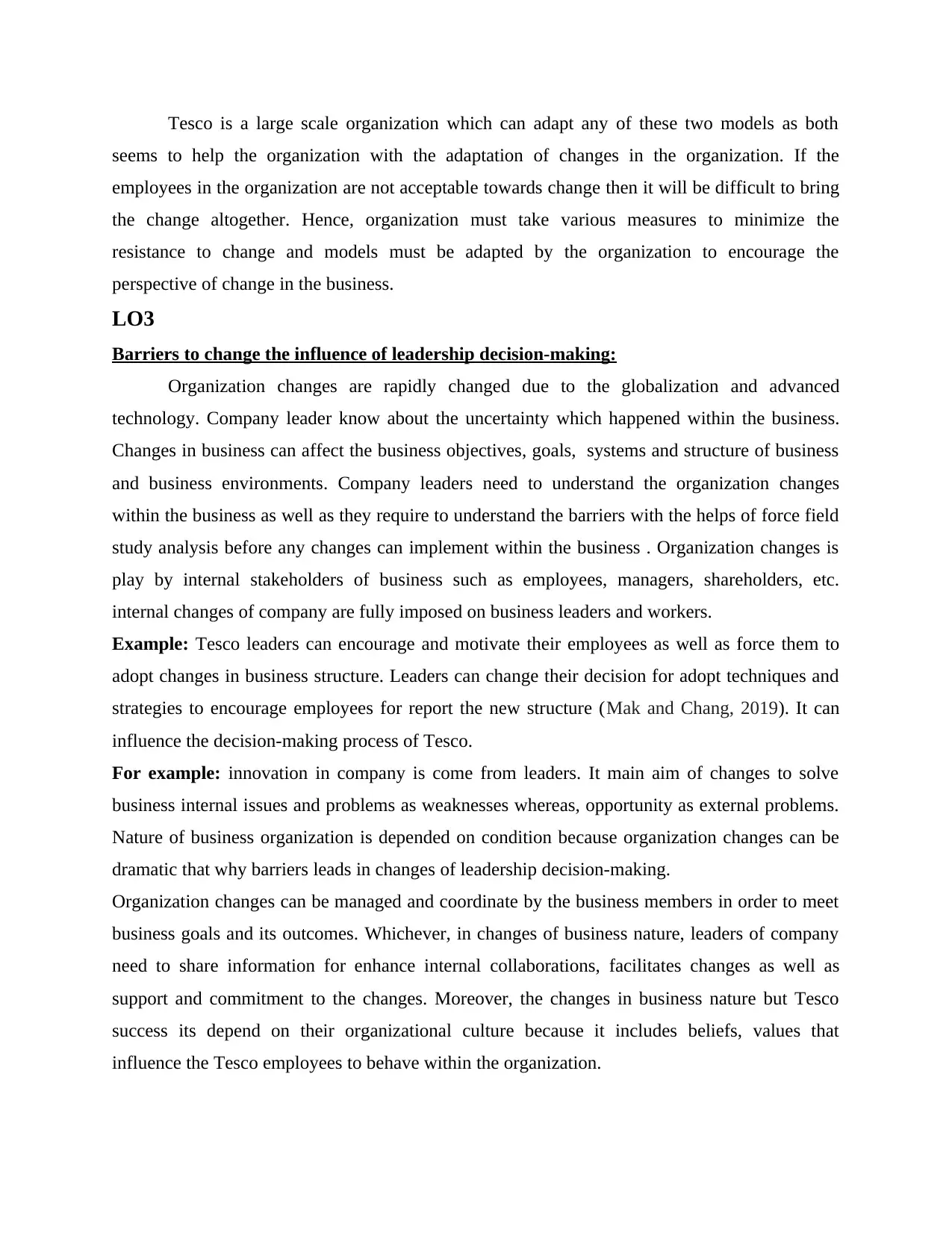
Tesco is a large scale organization which can adapt any of these two models as both
seems to help the organization with the adaptation of changes in the organization. If the
employees in the organization are not acceptable towards change then it will be difficult to bring
the change altogether. Hence, organization must take various measures to minimize the
resistance to change and models must be adapted by the organization to encourage the
perspective of change in the business.
LO3
Barriers to change the influence of leadership decision-making:
Organization changes are rapidly changed due to the globalization and advanced
technology. Company leader know about the uncertainty which happened within the business.
Changes in business can affect the business objectives, goals, systems and structure of business
and business environments. Company leaders need to understand the organization changes
within the business as well as they require to understand the barriers with the helps of force field
study analysis before any changes can implement within the business . Organization changes is
play by internal stakeholders of business such as employees, managers, shareholders, etc.
internal changes of company are fully imposed on business leaders and workers.
Example: Tesco leaders can encourage and motivate their employees as well as force them to
adopt changes in business structure. Leaders can change their decision for adopt techniques and
strategies to encourage employees for report the new structure (Mak and Chang, 2019). It can
influence the decision-making process of Tesco.
For example: innovation in company is come from leaders. It main aim of changes to solve
business internal issues and problems as weaknesses whereas, opportunity as external problems.
Nature of business organization is depended on condition because organization changes can be
dramatic that why barriers leads in changes of leadership decision-making.
Organization changes can be managed and coordinate by the business members in order to meet
business goals and its outcomes. Whichever, in changes of business nature, leaders of company
need to share information for enhance internal collaborations, facilitates changes as well as
support and commitment to the changes. Moreover, the changes in business nature but Tesco
success its depend on their organizational culture because it includes beliefs, values that
influence the Tesco employees to behave within the organization.
seems to help the organization with the adaptation of changes in the organization. If the
employees in the organization are not acceptable towards change then it will be difficult to bring
the change altogether. Hence, organization must take various measures to minimize the
resistance to change and models must be adapted by the organization to encourage the
perspective of change in the business.
LO3
Barriers to change the influence of leadership decision-making:
Organization changes are rapidly changed due to the globalization and advanced
technology. Company leader know about the uncertainty which happened within the business.
Changes in business can affect the business objectives, goals, systems and structure of business
and business environments. Company leaders need to understand the organization changes
within the business as well as they require to understand the barriers with the helps of force field
study analysis before any changes can implement within the business . Organization changes is
play by internal stakeholders of business such as employees, managers, shareholders, etc.
internal changes of company are fully imposed on business leaders and workers.
Example: Tesco leaders can encourage and motivate their employees as well as force them to
adopt changes in business structure. Leaders can change their decision for adopt techniques and
strategies to encourage employees for report the new structure (Mak and Chang, 2019). It can
influence the decision-making process of Tesco.
For example: innovation in company is come from leaders. It main aim of changes to solve
business internal issues and problems as weaknesses whereas, opportunity as external problems.
Nature of business organization is depended on condition because organization changes can be
dramatic that why barriers leads in changes of leadership decision-making.
Organization changes can be managed and coordinate by the business members in order to meet
business goals and its outcomes. Whichever, in changes of business nature, leaders of company
need to share information for enhance internal collaborations, facilitates changes as well as
support and commitment to the changes. Moreover, the changes in business nature but Tesco
success its depend on their organizational culture because it includes beliefs, values that
influence the Tesco employees to behave within the organization.
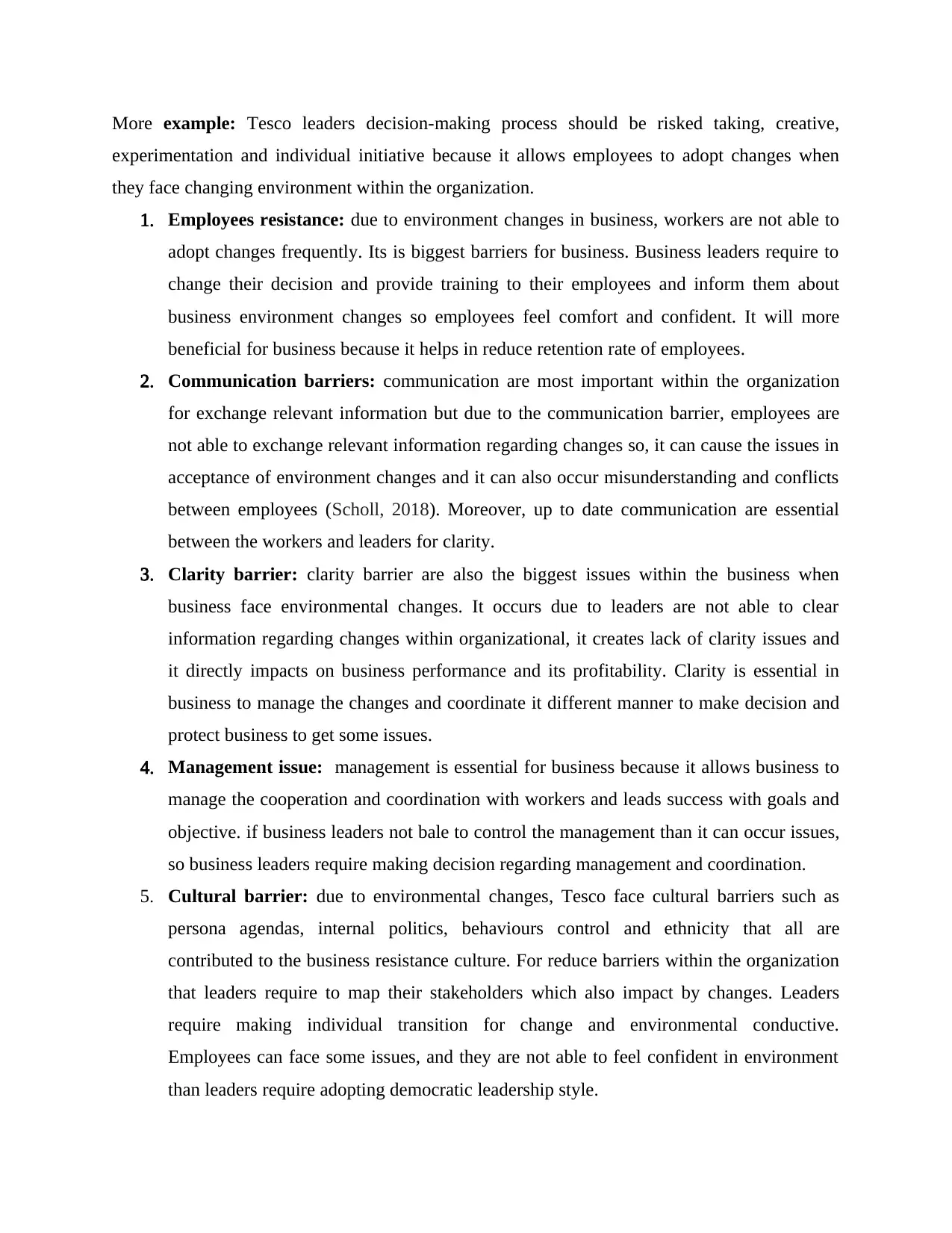
More example: Tesco leaders decision-making process should be risked taking, creative,
experimentation and individual initiative because it allows employees to adopt changes when
they face changing environment within the organization.
1. Employees resistance: due to environment changes in business, workers are not able to
adopt changes frequently. Its is biggest barriers for business. Business leaders require to
change their decision and provide training to their employees and inform them about
business environment changes so employees feel comfort and confident. It will more
beneficial for business because it helps in reduce retention rate of employees.
2. Communication barriers: communication are most important within the organization
for exchange relevant information but due to the communication barrier, employees are
not able to exchange relevant information regarding changes so, it can cause the issues in
acceptance of environment changes and it can also occur misunderstanding and conflicts
between employees (Scholl, 2018). Moreover, up to date communication are essential
between the workers and leaders for clarity.
3. Clarity barrier: clarity barrier are also the biggest issues within the business when
business face environmental changes. It occurs due to leaders are not able to clear
information regarding changes within organizational, it creates lack of clarity issues and
it directly impacts on business performance and its profitability. Clarity is essential in
business to manage the changes and coordinate it different manner to make decision and
protect business to get some issues.
4. Management issue: management is essential for business because it allows business to
manage the cooperation and coordination with workers and leads success with goals and
objective. if business leaders not bale to control the management than it can occur issues,
so business leaders require making decision regarding management and coordination.
5. Cultural barrier: due to environmental changes, Tesco face cultural barriers such as
persona agendas, internal politics, behaviours control and ethnicity that all are
contributed to the business resistance culture. For reduce barriers within the organization
that leaders require to map their stakeholders which also impact by changes. Leaders
require making individual transition for change and environmental conductive.
Employees can face some issues, and they are not able to feel confident in environment
than leaders require adopting democratic leadership style.
experimentation and individual initiative because it allows employees to adopt changes when
they face changing environment within the organization.
1. Employees resistance: due to environment changes in business, workers are not able to
adopt changes frequently. Its is biggest barriers for business. Business leaders require to
change their decision and provide training to their employees and inform them about
business environment changes so employees feel comfort and confident. It will more
beneficial for business because it helps in reduce retention rate of employees.
2. Communication barriers: communication are most important within the organization
for exchange relevant information but due to the communication barrier, employees are
not able to exchange relevant information regarding changes so, it can cause the issues in
acceptance of environment changes and it can also occur misunderstanding and conflicts
between employees (Scholl, 2018). Moreover, up to date communication are essential
between the workers and leaders for clarity.
3. Clarity barrier: clarity barrier are also the biggest issues within the business when
business face environmental changes. It occurs due to leaders are not able to clear
information regarding changes within organizational, it creates lack of clarity issues and
it directly impacts on business performance and its profitability. Clarity is essential in
business to manage the changes and coordinate it different manner to make decision and
protect business to get some issues.
4. Management issue: management is essential for business because it allows business to
manage the cooperation and coordination with workers and leads success with goals and
objective. if business leaders not bale to control the management than it can occur issues,
so business leaders require making decision regarding management and coordination.
5. Cultural barrier: due to environmental changes, Tesco face cultural barriers such as
persona agendas, internal politics, behaviours control and ethnicity that all are
contributed to the business resistance culture. For reduce barriers within the organization
that leaders require to map their stakeholders which also impact by changes. Leaders
require making individual transition for change and environmental conductive.
Employees can face some issues, and they are not able to feel confident in environment
than leaders require adopting democratic leadership style.
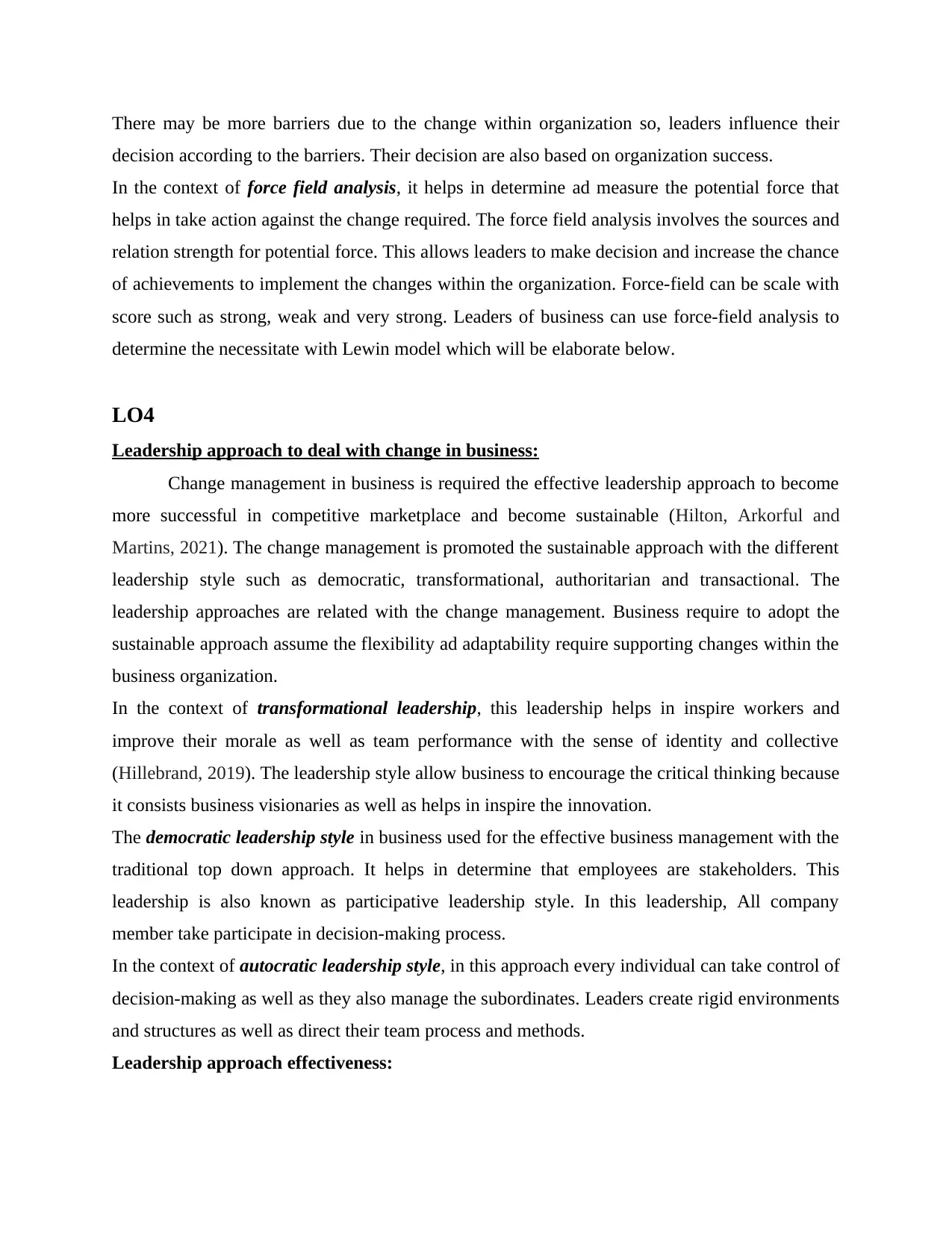
There may be more barriers due to the change within organization so, leaders influence their
decision according to the barriers. Their decision are also based on organization success.
In the context of force field analysis, it helps in determine ad measure the potential force that
helps in take action against the change required. The force field analysis involves the sources and
relation strength for potential force. This allows leaders to make decision and increase the chance
of achievements to implement the changes within the organization. Force-field can be scale with
score such as strong, weak and very strong. Leaders of business can use force-field analysis to
determine the necessitate with Lewin model which will be elaborate below.
LO4
Leadership approach to deal with change in business:
Change management in business is required the effective leadership approach to become
more successful in competitive marketplace and become sustainable (Hilton, Arkorful and
Martins, 2021). The change management is promoted the sustainable approach with the different
leadership style such as democratic, transformational, authoritarian and transactional. The
leadership approaches are related with the change management. Business require to adopt the
sustainable approach assume the flexibility ad adaptability require supporting changes within the
business organization.
In the context of transformational leadership, this leadership helps in inspire workers and
improve their morale as well as team performance with the sense of identity and collective
(Hillebrand, 2019). The leadership style allow business to encourage the critical thinking because
it consists business visionaries as well as helps in inspire the innovation.
The democratic leadership style in business used for the effective business management with the
traditional top down approach. It helps in determine that employees are stakeholders. This
leadership is also known as participative leadership style. In this leadership, All company
member take participate in decision-making process.
In the context of autocratic leadership style, in this approach every individual can take control of
decision-making as well as they also manage the subordinates. Leaders create rigid environments
and structures as well as direct their team process and methods.
Leadership approach effectiveness:
decision according to the barriers. Their decision are also based on organization success.
In the context of force field analysis, it helps in determine ad measure the potential force that
helps in take action against the change required. The force field analysis involves the sources and
relation strength for potential force. This allows leaders to make decision and increase the chance
of achievements to implement the changes within the organization. Force-field can be scale with
score such as strong, weak and very strong. Leaders of business can use force-field analysis to
determine the necessitate with Lewin model which will be elaborate below.
LO4
Leadership approach to deal with change in business:
Change management in business is required the effective leadership approach to become
more successful in competitive marketplace and become sustainable (Hilton, Arkorful and
Martins, 2021). The change management is promoted the sustainable approach with the different
leadership style such as democratic, transformational, authoritarian and transactional. The
leadership approaches are related with the change management. Business require to adopt the
sustainable approach assume the flexibility ad adaptability require supporting changes within the
business organization.
In the context of transformational leadership, this leadership helps in inspire workers and
improve their morale as well as team performance with the sense of identity and collective
(Hillebrand, 2019). The leadership style allow business to encourage the critical thinking because
it consists business visionaries as well as helps in inspire the innovation.
The democratic leadership style in business used for the effective business management with the
traditional top down approach. It helps in determine that employees are stakeholders. This
leadership is also known as participative leadership style. In this leadership, All company
member take participate in decision-making process.
In the context of autocratic leadership style, in this approach every individual can take control of
decision-making as well as they also manage the subordinates. Leaders create rigid environments
and structures as well as direct their team process and methods.
Leadership approach effectiveness:
Secure Best Marks with AI Grader
Need help grading? Try our AI Grader for instant feedback on your assignments.
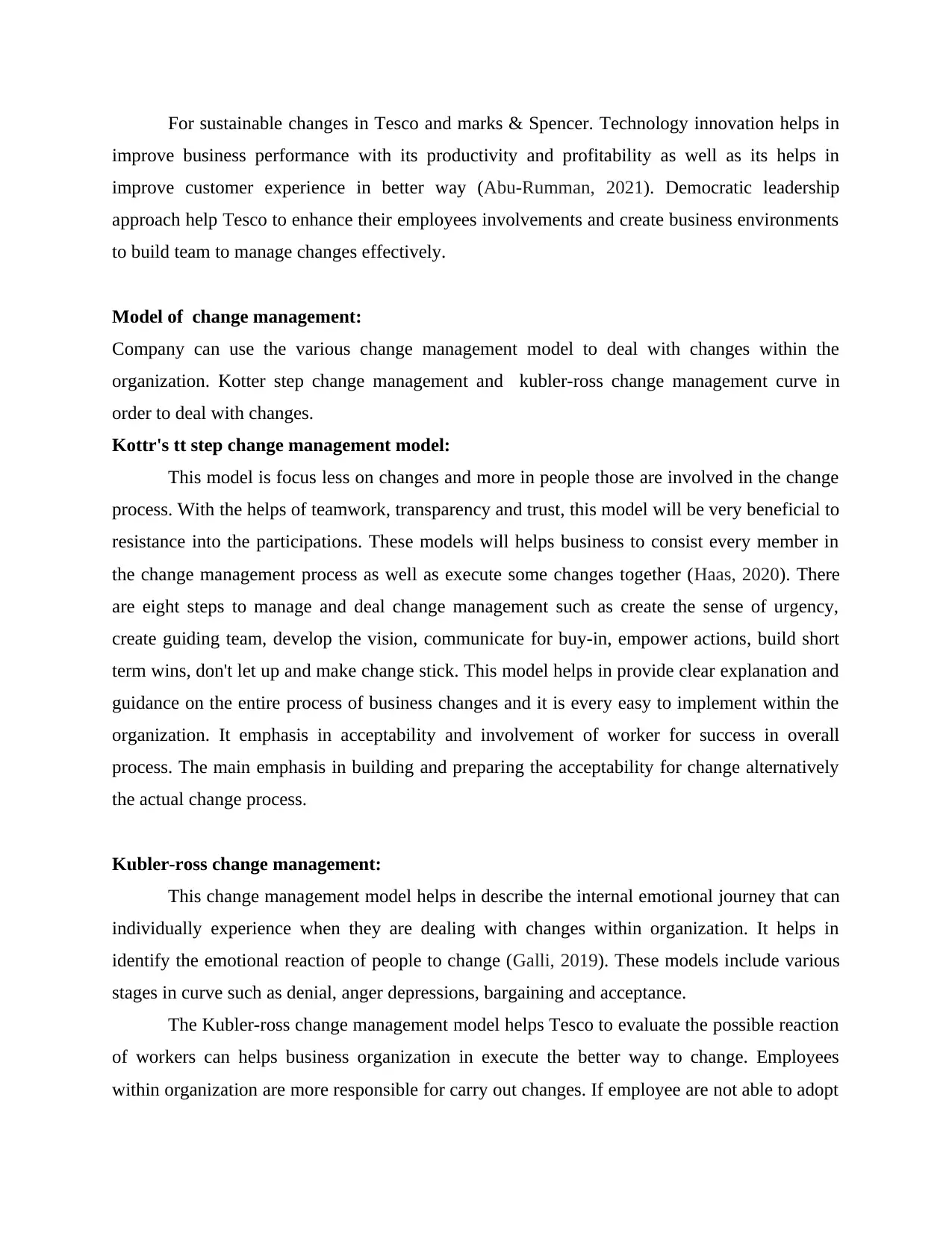
For sustainable changes in Tesco and marks & Spencer. Technology innovation helps in
improve business performance with its productivity and profitability as well as its helps in
improve customer experience in better way (Abu-Rumman, 2021). Democratic leadership
approach help Tesco to enhance their employees involvements and create business environments
to build team to manage changes effectively.
Model of change management:
Company can use the various change management model to deal with changes within the
organization. Kotter step change management and kubler-ross change management curve in
order to deal with changes.
Kottr's tt step change management model:
This model is focus less on changes and more in people those are involved in the change
process. With the helps of teamwork, transparency and trust, this model will be very beneficial to
resistance into the participations. These models will helps business to consist every member in
the change management process as well as execute some changes together (Haas, 2020). There
are eight steps to manage and deal change management such as create the sense of urgency,
create guiding team, develop the vision, communicate for buy-in, empower actions, build short
term wins, don't let up and make change stick. This model helps in provide clear explanation and
guidance on the entire process of business changes and it is every easy to implement within the
organization. It emphasis in acceptability and involvement of worker for success in overall
process. The main emphasis in building and preparing the acceptability for change alternatively
the actual change process.
Kubler-ross change management:
This change management model helps in describe the internal emotional journey that can
individually experience when they are dealing with changes within organization. It helps in
identify the emotional reaction of people to change (Galli, 2019). These models include various
stages in curve such as denial, anger depressions, bargaining and acceptance.
The Kubler-ross change management model helps Tesco to evaluate the possible reaction
of workers can helps business organization in execute the better way to change. Employees
within organization are more responsible for carry out changes. If employee are not able to adopt
improve business performance with its productivity and profitability as well as its helps in
improve customer experience in better way (Abu-Rumman, 2021). Democratic leadership
approach help Tesco to enhance their employees involvements and create business environments
to build team to manage changes effectively.
Model of change management:
Company can use the various change management model to deal with changes within the
organization. Kotter step change management and kubler-ross change management curve in
order to deal with changes.
Kottr's tt step change management model:
This model is focus less on changes and more in people those are involved in the change
process. With the helps of teamwork, transparency and trust, this model will be very beneficial to
resistance into the participations. These models will helps business to consist every member in
the change management process as well as execute some changes together (Haas, 2020). There
are eight steps to manage and deal change management such as create the sense of urgency,
create guiding team, develop the vision, communicate for buy-in, empower actions, build short
term wins, don't let up and make change stick. This model helps in provide clear explanation and
guidance on the entire process of business changes and it is every easy to implement within the
organization. It emphasis in acceptability and involvement of worker for success in overall
process. The main emphasis in building and preparing the acceptability for change alternatively
the actual change process.
Kubler-ross change management:
This change management model helps in describe the internal emotional journey that can
individually experience when they are dealing with changes within organization. It helps in
identify the emotional reaction of people to change (Galli, 2019). These models include various
stages in curve such as denial, anger depressions, bargaining and acceptance.
The Kubler-ross change management model helps Tesco to evaluate the possible reaction
of workers can helps business organization in execute the better way to change. Employees
within organization are more responsible for carry out changes. If employee are not able to adopt
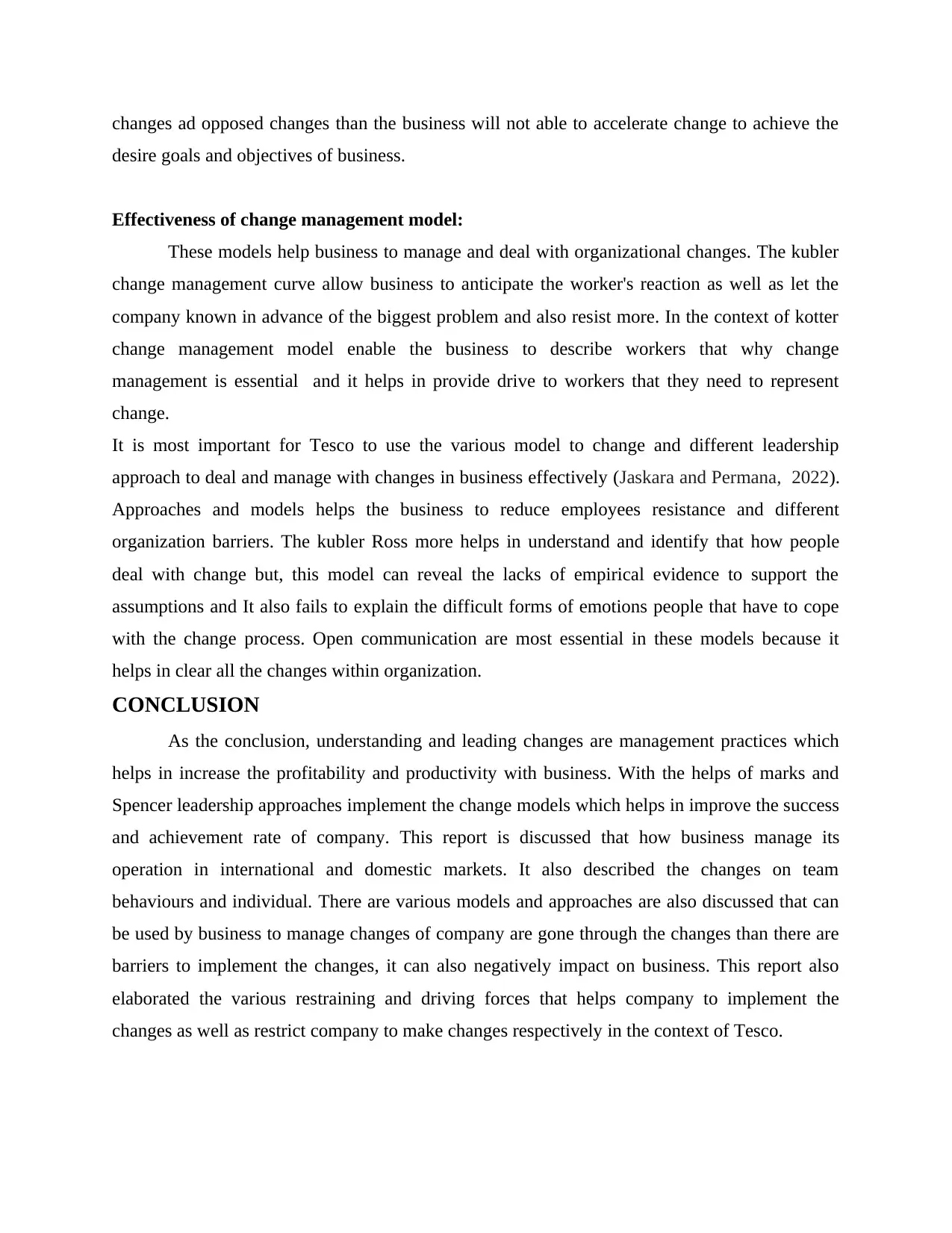
changes ad opposed changes than the business will not able to accelerate change to achieve the
desire goals and objectives of business.
Effectiveness of change management model:
These models help business to manage and deal with organizational changes. The kubler
change management curve allow business to anticipate the worker's reaction as well as let the
company known in advance of the biggest problem and also resist more. In the context of kotter
change management model enable the business to describe workers that why change
management is essential and it helps in provide drive to workers that they need to represent
change.
It is most important for Tesco to use the various model to change and different leadership
approach to deal and manage with changes in business effectively (Jaskara and Permana, 2022).
Approaches and models helps the business to reduce employees resistance and different
organization barriers. The kubler Ross more helps in understand and identify that how people
deal with change but, this model can reveal the lacks of empirical evidence to support the
assumptions and It also fails to explain the difficult forms of emotions people that have to cope
with the change process. Open communication are most essential in these models because it
helps in clear all the changes within organization.
CONCLUSION
As the conclusion, understanding and leading changes are management practices which
helps in increase the profitability and productivity with business. With the helps of marks and
Spencer leadership approaches implement the change models which helps in improve the success
and achievement rate of company. This report is discussed that how business manage its
operation in international and domestic markets. It also described the changes on team
behaviours and individual. There are various models and approaches are also discussed that can
be used by business to manage changes of company are gone through the changes than there are
barriers to implement the changes, it can also negatively impact on business. This report also
elaborated the various restraining and driving forces that helps company to implement the
changes as well as restrict company to make changes respectively in the context of Tesco.
desire goals and objectives of business.
Effectiveness of change management model:
These models help business to manage and deal with organizational changes. The kubler
change management curve allow business to anticipate the worker's reaction as well as let the
company known in advance of the biggest problem and also resist more. In the context of kotter
change management model enable the business to describe workers that why change
management is essential and it helps in provide drive to workers that they need to represent
change.
It is most important for Tesco to use the various model to change and different leadership
approach to deal and manage with changes in business effectively (Jaskara and Permana, 2022).
Approaches and models helps the business to reduce employees resistance and different
organization barriers. The kubler Ross more helps in understand and identify that how people
deal with change but, this model can reveal the lacks of empirical evidence to support the
assumptions and It also fails to explain the difficult forms of emotions people that have to cope
with the change process. Open communication are most essential in these models because it
helps in clear all the changes within organization.
CONCLUSION
As the conclusion, understanding and leading changes are management practices which
helps in increase the profitability and productivity with business. With the helps of marks and
Spencer leadership approaches implement the change models which helps in improve the success
and achievement rate of company. This report is discussed that how business manage its
operation in international and domestic markets. It also described the changes on team
behaviours and individual. There are various models and approaches are also discussed that can
be used by business to manage changes of company are gone through the changes than there are
barriers to implement the changes, it can also negatively impact on business. This report also
elaborated the various restraining and driving forces that helps company to implement the
changes as well as restrict company to make changes respectively in the context of Tesco.

Paraphrase This Document
Need a fresh take? Get an instant paraphrase of this document with our AI Paraphraser
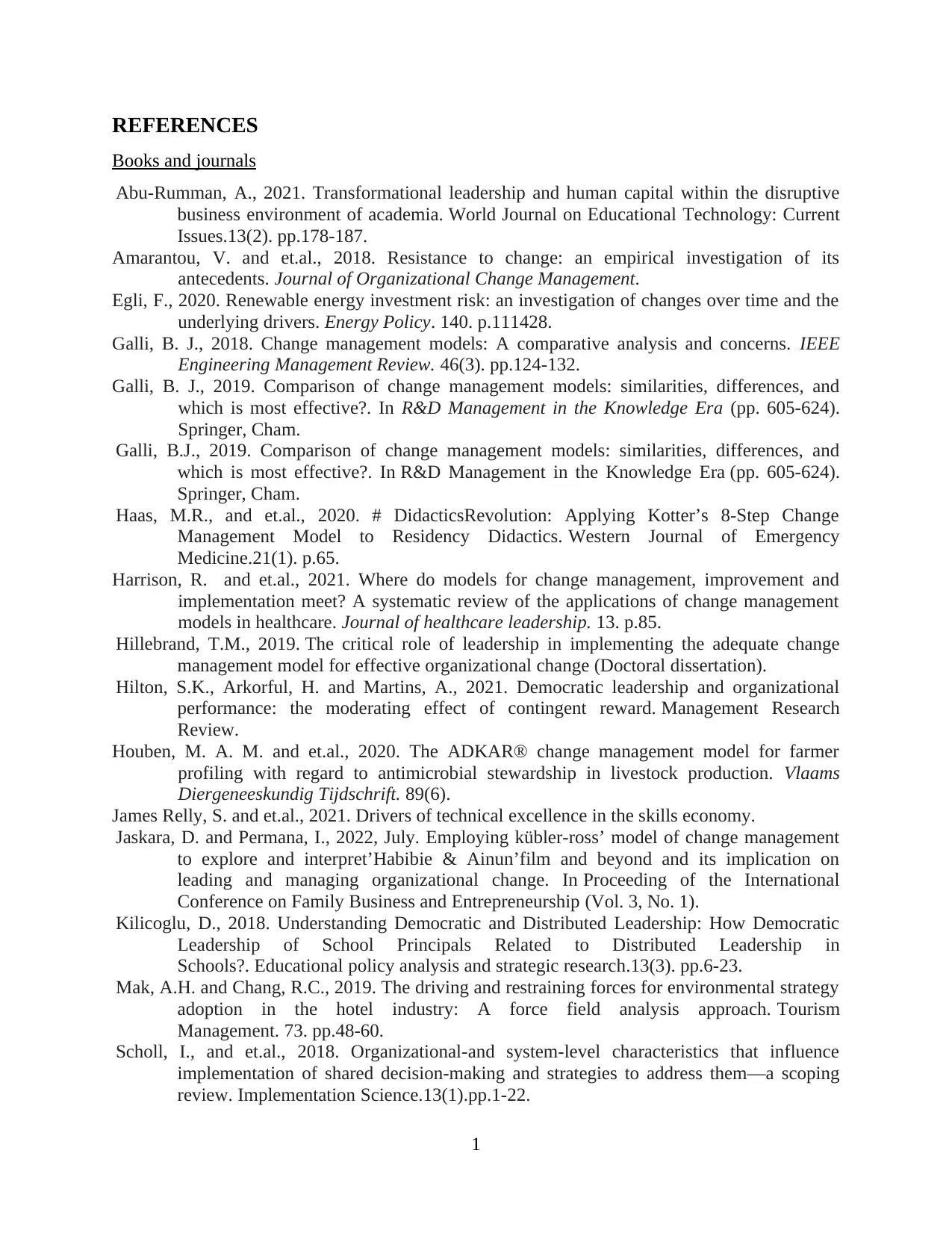
REFERENCES
Books and journals
Abu-Rumman, A., 2021. Transformational leadership and human capital within the disruptive
business environment of academia. World Journal on Educational Technology: Current
Issues.13(2). pp.178-187.
Amarantou, V. and et.al., 2018. Resistance to change: an empirical investigation of its
antecedents. Journal of Organizational Change Management.
Egli, F., 2020. Renewable energy investment risk: an investigation of changes over time and the
underlying drivers. Energy Policy. 140. p.111428.
Galli, B. J., 2018. Change management models: A comparative analysis and concerns. IEEE
Engineering Management Review. 46(3). pp.124-132.
Galli, B. J., 2019. Comparison of change management models: similarities, differences, and
which is most effective?. In R&D Management in the Knowledge Era (pp. 605-624).
Springer, Cham.
Galli, B.J., 2019. Comparison of change management models: similarities, differences, and
which is most effective?. In R&D Management in the Knowledge Era (pp. 605-624).
Springer, Cham.
Haas, M.R., and et.al., 2020. # DidacticsRevolution: Applying Kotter’s 8-Step Change
Management Model to Residency Didactics. Western Journal of Emergency
Medicine.21(1). p.65.
Harrison, R. and et.al., 2021. Where do models for change management, improvement and
implementation meet? A systematic review of the applications of change management
models in healthcare. Journal of healthcare leadership. 13. p.85.
Hillebrand, T.M., 2019. The critical role of leadership in implementing the adequate change
management model for effective organizational change (Doctoral dissertation).
Hilton, S.K., Arkorful, H. and Martins, A., 2021. Democratic leadership and organizational
performance: the moderating effect of contingent reward. Management Research
Review.
Houben, M. A. M. and et.al., 2020. The ADKAR® change management model for farmer
profiling with regard to antimicrobial stewardship in livestock production. Vlaams
Diergeneeskundig Tijdschrift. 89(6).
James Relly, S. and et.al., 2021. Drivers of technical excellence in the skills economy.
Jaskara, D. and Permana, I., 2022, July. Employing kübler-ross’ model of change management
to explore and interpret’Habibie & Ainun’film and beyond and its implication on
leading and managing organizational change. In Proceeding of the International
Conference on Family Business and Entrepreneurship (Vol. 3, No. 1).
Kilicoglu, D., 2018. Understanding Democratic and Distributed Leadership: How Democratic
Leadership of School Principals Related to Distributed Leadership in
Schools?. Educational policy analysis and strategic research.13(3). pp.6-23.
Mak, A.H. and Chang, R.C., 2019. The driving and restraining forces for environmental strategy
adoption in the hotel industry: A force field analysis approach. Tourism
Management. 73. pp.48-60.
Scholl, I., and et.al., 2018. Organizational-and system-level characteristics that influence
implementation of shared decision-making and strategies to address them—a scoping
review. Implementation Science.13(1).pp.1-22.
1
Books and journals
Abu-Rumman, A., 2021. Transformational leadership and human capital within the disruptive
business environment of academia. World Journal on Educational Technology: Current
Issues.13(2). pp.178-187.
Amarantou, V. and et.al., 2018. Resistance to change: an empirical investigation of its
antecedents. Journal of Organizational Change Management.
Egli, F., 2020. Renewable energy investment risk: an investigation of changes over time and the
underlying drivers. Energy Policy. 140. p.111428.
Galli, B. J., 2018. Change management models: A comparative analysis and concerns. IEEE
Engineering Management Review. 46(3). pp.124-132.
Galli, B. J., 2019. Comparison of change management models: similarities, differences, and
which is most effective?. In R&D Management in the Knowledge Era (pp. 605-624).
Springer, Cham.
Galli, B.J., 2019. Comparison of change management models: similarities, differences, and
which is most effective?. In R&D Management in the Knowledge Era (pp. 605-624).
Springer, Cham.
Haas, M.R., and et.al., 2020. # DidacticsRevolution: Applying Kotter’s 8-Step Change
Management Model to Residency Didactics. Western Journal of Emergency
Medicine.21(1). p.65.
Harrison, R. and et.al., 2021. Where do models for change management, improvement and
implementation meet? A systematic review of the applications of change management
models in healthcare. Journal of healthcare leadership. 13. p.85.
Hillebrand, T.M., 2019. The critical role of leadership in implementing the adequate change
management model for effective organizational change (Doctoral dissertation).
Hilton, S.K., Arkorful, H. and Martins, A., 2021. Democratic leadership and organizational
performance: the moderating effect of contingent reward. Management Research
Review.
Houben, M. A. M. and et.al., 2020. The ADKAR® change management model for farmer
profiling with regard to antimicrobial stewardship in livestock production. Vlaams
Diergeneeskundig Tijdschrift. 89(6).
James Relly, S. and et.al., 2021. Drivers of technical excellence in the skills economy.
Jaskara, D. and Permana, I., 2022, July. Employing kübler-ross’ model of change management
to explore and interpret’Habibie & Ainun’film and beyond and its implication on
leading and managing organizational change. In Proceeding of the International
Conference on Family Business and Entrepreneurship (Vol. 3, No. 1).
Kilicoglu, D., 2018. Understanding Democratic and Distributed Leadership: How Democratic
Leadership of School Principals Related to Distributed Leadership in
Schools?. Educational policy analysis and strategic research.13(3). pp.6-23.
Mak, A.H. and Chang, R.C., 2019. The driving and restraining forces for environmental strategy
adoption in the hotel industry: A force field analysis approach. Tourism
Management. 73. pp.48-60.
Scholl, I., and et.al., 2018. Organizational-and system-level characteristics that influence
implementation of shared decision-making and strategies to address them—a scoping
review. Implementation Science.13(1).pp.1-22.
1
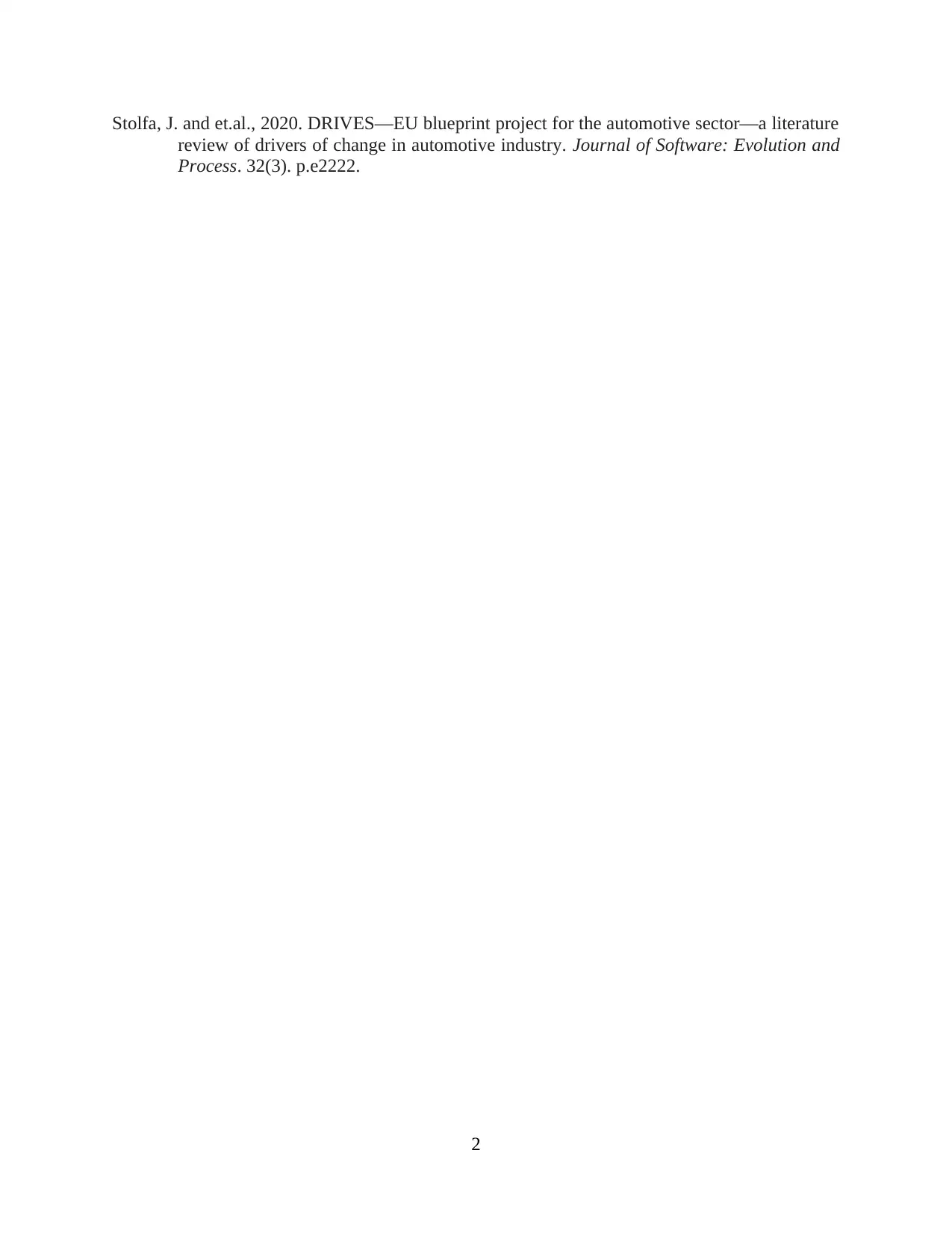
Stolfa, J. and et.al., 2020. DRIVES—EU blueprint project for the automotive sector—a literature
review of drivers of change in automotive industry. Journal of Software: Evolution and
Process. 32(3). p.e2222.
2
review of drivers of change in automotive industry. Journal of Software: Evolution and
Process. 32(3). p.e2222.
2
1 out of 15
Related Documents
Your All-in-One AI-Powered Toolkit for Academic Success.
+13062052269
info@desklib.com
Available 24*7 on WhatsApp / Email
![[object Object]](/_next/static/media/star-bottom.7253800d.svg)
Unlock your academic potential
© 2024 | Zucol Services PVT LTD | All rights reserved.



